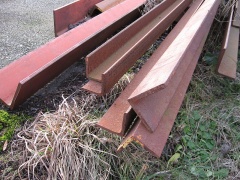Difference between revisions of "Steel profiles"
From Cargo Handbook - the world's largest cargo transport guidelines website
| Line 1: | Line 1: | ||
{{Infobox_Metals | {{Infobox_Metals | ||
| image = profiles.jpg | | image = profiles.jpg | ||
| − | | origin = | + | | origin = Trade in steel and steel products primarily flows:<ul><li>EU countries</li><li>Asia: Japan, Korea, India, South Africa</li><li>America: USA |
| − | | stowage factor = | + | | stowage factor = Highly variable, depending upon packaging, dimensions and weight, e.g.: 0.83 m³/t (concrete reinforcement steel in bundles with metal strapping |
| − | | humidity and moisture = | + | | humidity and moisture = Relative humidity: <40 - 50% |
| − | | ventilation = | + | | ventilation = (See text also) Steel profiles require particular humidity/moisture and possibly ventilation conditions. Steel corrosion accelerates rapidly at relative humidity > 60%. If possible, relative humidity should be reduced to below 60% by appropriate ventilation measures. |
| − | | risk factors = | + | | risk factors = (See text also) Seawater damage, contamination and mechanical damage |
}} | }} | ||
Revision as of 17:35, 17 March 2012
| Infobox on Steel profiles | |
|---|---|
| Example of Steel profiles |  |
| Facts | |
| Origin | Trade in steel and steel products primarily flows:
|
| Stowage factor (in m3/t) | Highly variable, depending upon packaging, dimensions and weight, e.g.: 0.83 m³/t (concrete reinforcement steel in bundles with metal strapping |
| Humidity / moisture | Relative humidity: <40 - 50% |
| Ventilation | (See text also) Steel profiles require particular humidity/moisture and possibly ventilation conditions. Steel corrosion accelerates rapidly at relative humidity > 60%. If possible, relative humidity should be reduced to below 60% by appropriate ventilation measures. |
| Risk factors | (See text also) Seawater damage, contamination and mechanical damage |











